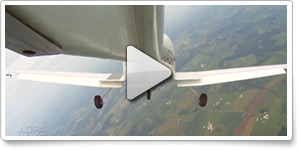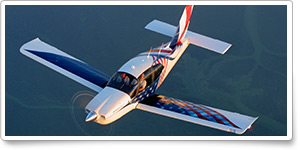Oct. 5, 2012, issue of 'AOPA ePilot: Flight Training Edition' weekly newsletter
| Comments? email [email protected], call 800/USA-AOPA | ||||||
| ||||||
| Treating transponder transgressions |
| |||||
Training TipsTreating transponder transgressions
Transponder operation is simplicity itself: You enter the assigned code and wait to hear the magic words, “Radar contact,” from ATC. Or enter the VFR code (1200) if you will not be in radio contact with ATC during a flight.
Simple—but there’s a right way and a wrong way to operate your transponder. Details matter, and proper technique helps keep the traffic in your airspace flowing smoothly.
An important but sometimes overlooked detail is when to turn your transponder to the on or normal altitude reporting position, and guidance on that subject has been the subject of a recent update. Although it was widespread practice in the past to taxi with a transponder set to standby because it was asserted that a taxiing aircraft merely cluttered radar, that approach to transponder use has changed. Section 4-1-20 of the Aeronautical Information Manual was amended earlier this year, and now instructs pilots to turn their transponders on “prior to moving on the airport surface to ensure the aircraft is visible to ATC surveillance systems.”
Sometimes during a flight, ATC may change your assigned code. It isn’t necessary to switch to standby mode while making the change. An air traffic controller explains what is seen at the radar scope as you change codes in this Air Safety Institute Ask ATC video.
In a pinch, your transponder can serve as a back-up form of two-way communications. This Flight Training “Learning Experience” column relates how a pilot who could receive but not send radio transmissions was able to comply with ATC instructions using the ident feature of a transponder—after squawking code 7600 to inform ATC of the predicament.
A related tip is to refrain from using the ident feature unless instructed to do so. Proper ident etiquette is an important element of eradicating transponder transgressions! Flight Training NewsFlight Design pitches trans-Atlantic adventureFlight Design has lined up briefing and planning resources for buyers interested in taking a European tour in their brand-new CTLSi light sport aircraft. The promotion also presents the option of flying home to North America for pilots with an “extra measure of adventurous spirit.” Read more >> Whirly-Girls extends scholarship deadlineWhirly-Girls, International Women Helicopter Pilots, has extended the deadline for scholarship applications to Nov. 1. Scholarships are available for add-on flight training for a certificated female pilot, safety training, mountain flying, turbine training, type training in a Bell 206, and more. For information and applications, see the website. Need more of a challenge? Head to the hillsMountain flying doesn’t necessarily add to the challenges of aviation, but it certainly exacerbates them. All of the issues flatland pilots have to contend with—wind, weather, aircraft performance—are given extra special consideration when pilots are peering down at less-than-forgiving terrain. And veteran mountain flyers will tell you: It’s a lot different than flying in the lowlands. Learn what makes flying in the mountains so special, and challenging, in the Air Safety Institute’s Mountain Flying online course. NAA to honor King Schools’ John and Martha KingThe National Aeronautic Association will honor well-known aviation educators John and Martha King of King Schools Nov. 13 for significant contributions to pilot training. The Kings will receive the NAA’s 2012 Brewer Trophy for Aviation Education at an awards ceremony in Arlington, Va. The organization also will recognize the careers of five aviation statesmen. Read more >> Know thyself…Yes, it can happen to you! A concern for pilots of all ages is the effects of spatial disorientation—the mistaken perception of one’s position and motion relative to the Earth—in flight. Learn how this happens, and how to prevent and manage its effects. Read the Air Safety Institute’s Spatial Disorientation Safety Advisor. Training ResourcesYour solo cross-country flight is on the calendar, and now’s the time to plan it. Do you know whether there’s a temporary flight restriction (TFR) along your route? It won’t be on your sectional chart! Take the time to find out before you file your flight plan. Use AOPA’s TFR map to get a look at all TFRs planned for your proposed route. The map depicts active (red and yellow) as well as not-yet-active TFRs (black). The AOPA Internet Flight Planner will also show you if a TFR is on or near your proposed route of flight. Be sure to verify with a flight briefer just before your flight, as TFRs can change with little notice.
Did you know that student pilots who join AOPA are three times more likely to complete their flight training? Membership includes unlimited access to aviation information by phone (800/USA-AOPA, weekdays from 8:30 a.m. to 6 p.m. Eastern time) or from Flight Training Online or AOPA Online. If you’re not already a member, join today and get the pilot’s edge. Login information is available online. Emergency descents Career PilotUnited accepts first new DreamlinerBoeing delivered to United Airlines the carrier’s first 787 Dreamliner on Sept. 24. United, the first airline in North America to take delivery of the new twinjet, has announced it will temporarily use its 787 aircraft in domestic service before transitioning them to international routes between the United States and Africa, Asia, and Europe. United has 50 composite Dreamliners on order, configured with 219 seats in three classes. It said the first 787 will begin a month-long training and certification program that includes noncommercial flights to each of United’s domestic hubs. United to launch new routes from Cleveland hubUnited Airlines announced Sept. 20 that it will launch daily nonstop service from its Cleveland hub at Hopkins International Airport to Nashville and Oklahoma City, Okla. The new United Express flights will be operated by ExpressJet using 50-seat regional jets. The service to Nashville will begin Dec. 19, and the Oklahoma City service will begin Feb. 14, 2013. Plane SpotterThe Caribbean collection: Socata TB20 Trinidad Training Products2012 Sporty’s crystal holiday ornamentWhen Sporty’s unveils its annual crystal Christmas ornament, you know the holidays are not too far away. This year’s edition celebrates the seventy-fifth anniversary of Piper Aircraft, with the iconic Piper J-3 Cub. The ornament is priced at $24.95; an ornament display stand is $5.99. Order online or call 800/776-7897.
Note: Products listed have not been evaluated by ePilot editors unless otherwise noted. AOPA assumes no responsibility for products or services listed or for claims or actions by manufacturers or vendors. Member BenefitsMedXpress is mandatoryOn Oct. 1, the paper 8500-8 medical application form went away, and the FAA’s MedXpress online form system took its place. AOPA’s Director of Medical Certification Gary Crump explains how the system works and what you will need to do before you head to the aviation medical examiner’s office. Read more >> No risk when you enroll in Emergency Assistance PlusEmergency Assistance Plus (EA+) is a service intended to fill the gap when accidents, illness, or other problems arise away from home for expenditures that health insurance doesn’t cover. EA+ and AOPA are so sure that this program is beneficial to you that you can apply for the program at no risk. Read more >> BlogsWhen is 200 feet not 200 feet?Here’s a puzzler for you: If you were flying a 747 at 1,000 feet, how high would you actually be? It’s not a trick question, particularly when it comes to decision heights and minimum descent altitudes, as professional pilot Chip Wright explains in the Flight Training blog. ATC mayhem and landing practice at Santa RosaStudent pilot Blaine Transue has finished his solo, cross-country, and night-flying requirements, and his private pilot checkride is looming. In this installment of the Let’s Go Flying blog, he discusses a dual flight to busy Charles M. Schultz-Sonoma County Airport that tossed in a few extra challenges. AOPA Career OpportunitiesEver dream of turning your passion for aviation into a career? We’re looking for a strategy and financial analyst, executive assistant, director of media relations, major gifts officer, accounts payable technician, and Web graphic designer. To learn more about other AOPA career opportunities, visit AOPA Online. Community
AVIATION EVENTS & WEATHER
| ||||||||||||||||||||||||||||||||||||




 Your trainer’s transponder responds to “interrogations” from air traffic control radar, providing you with capability to use flight following and other services. When equipped with Mode C altitude-encoding capability, the transponder lets you request access to busy Class C or Class B airspace. (Transponder requirements are discussed in the Air Safety Institute’s
Your trainer’s transponder responds to “interrogations” from air traffic control radar, providing you with capability to use flight following and other services. When equipped with Mode C altitude-encoding capability, the transponder lets you request access to busy Class C or Class B airspace. (Transponder requirements are discussed in the Air Safety Institute’s 




